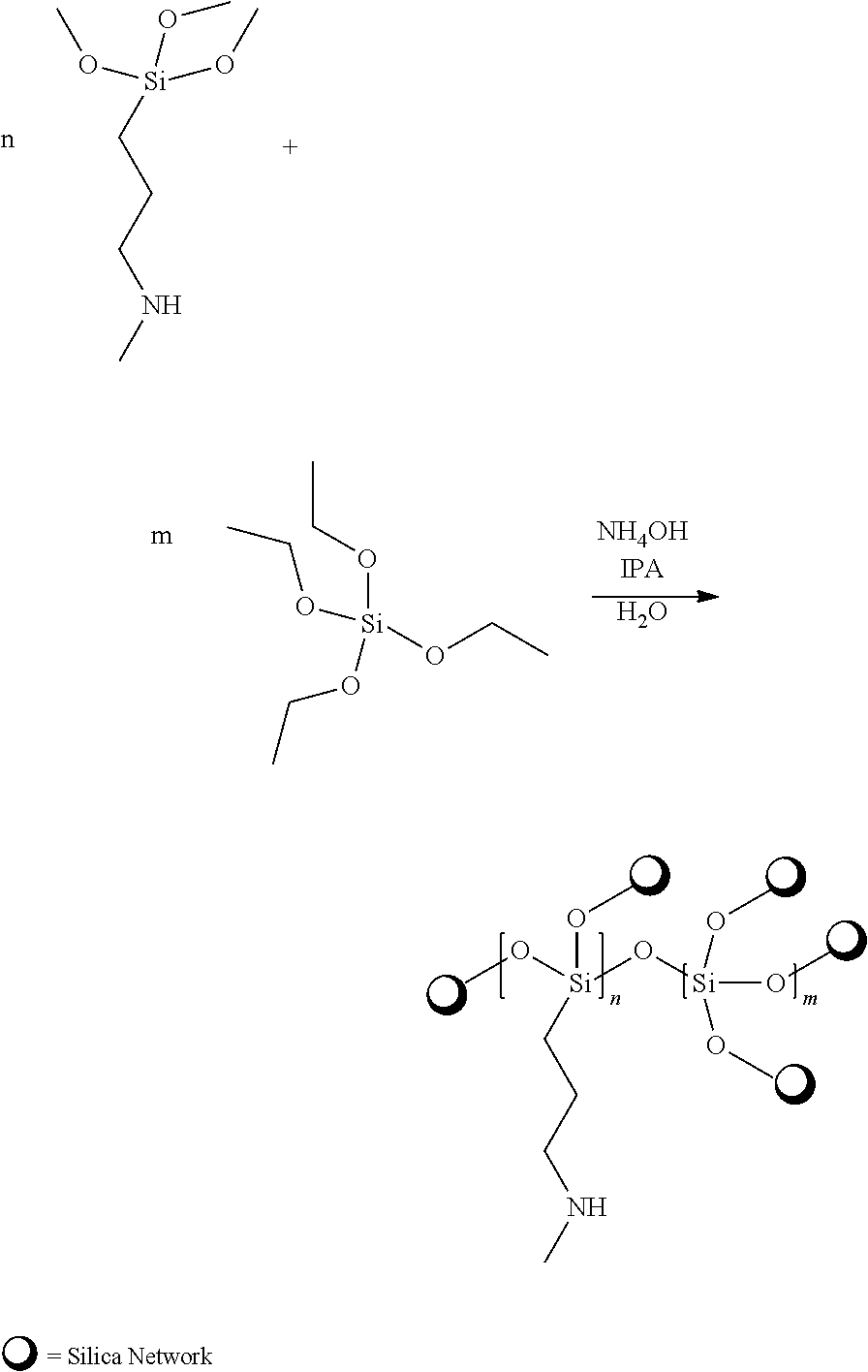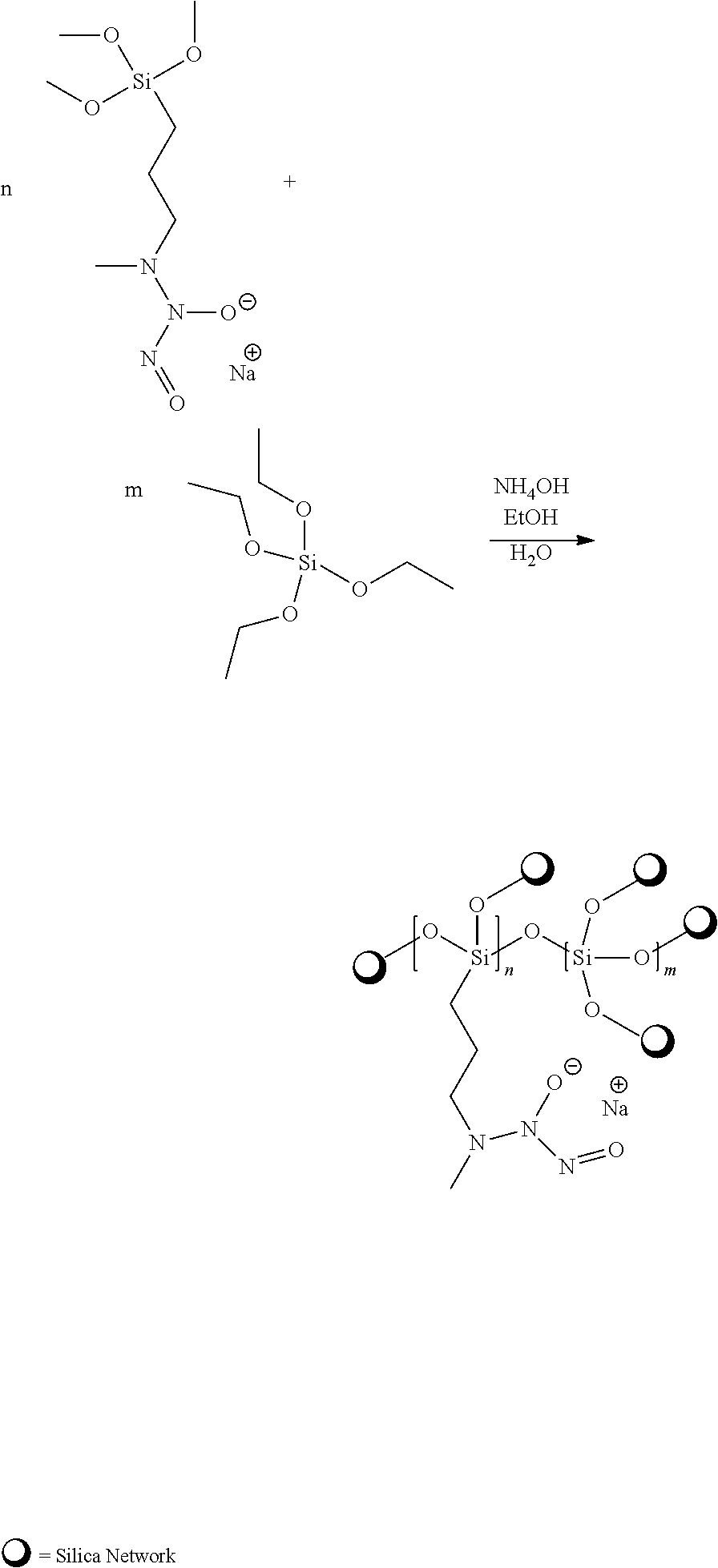Temperature controlled sol-gel co-condensation
a technology of solgel and co-condensation, which is applied in the field of temperature controlled solgel cocondensation, can solve the problems of difficult to obtain a homogeneous solution through control, affect composition and properties,
- Summary
- Abstract
- Description
- Claims
- Application Information
AI Technical Summary
Benefits of technology
Problems solved by technology
Method used
Image
Examples
example 1
Synthesis of co-condensed silica of N-methylaminopropyltrimethoxysilane (MAP3) and Tetraethoxysilane (TEOS)
[0068]
In a 250 ml round bottom flask, MAP3 (1.74 g, 9.0 mmol) was mixed with 20 ml of Isopropanol. The flask was flashed with nitrogen and then put in an ice / salt bath to chill to −5° C. while stirred magnetically. Into the cold mixture, TEOS (1.88 g, 9.0 mmol) was added. After the temperature stabilized, ammonium hydroxide solution (0.3 ml, 28%) was added. The homogeneous mixture was warmed slowly to room temperature. Solid started to precipitate after 10 minutes at room temperature. The reaction was kept for 2 hours, before the mixture was separated with centrifuge. The solid was washed with dry Ethanol 20 mL twice. The solid was dried overnight at room temperature under vacuum. The reaction produced 2.0 g of off white silica particles.
example 2
Synthesis of co-condensed silica of N-methylaminopropyltrimethoxysilane-Diazeniumdiolate (MAP3-NO) and TEOS, Lab Scale
[0069]
[0070]Both reactors in this reaction Were flashed with nitrogen. In a 2 liter round bottom flask, 500 ml of MeOH solution of sodium methylaminopropyltrimethoxysilaneNONOate (0.31 mol of total silane) was chilled to −15° C. in a dry ice bath. Ethanol (1000 mL) was added into the mixture. Wait till the temperature stabilized to −15° C., tetraethoxysilane (65.1 g, 0.31 mol) was added. After the temperature stabilized, DI Water (25 g, 1.39 mol) was added. Ammonium hydroxide aqueous solution (120 ml, 28%) was pre-chilled to −15° C. and added into the mixture. The mixture was a homogenous clear solution at this point. The content was transferred to a 2 liter jacketed reactor with mechanic stirring. The jacket temperature was set at 14° C. The temperature of the mixture increased to the equilibrium temperature of 14° C. in about 15 minutes. The stirring speed was cont...
example 3
Synthesis of co-condensed silica of N-MethylAminoPropylTrimethoxySilane-Diazeniumdiolate (MAP3-NO) and TEOS, manufacturing scale
[0071]The 20 liter jacketed reactor was equipped with an air motor, nitrogen inlet and a circulator. Ethanol (6240 g) was dispensed into the reactor. The agitator air pressure was turned on to at least 60 psig. The reactor was chilled to −13° C. over at least 60 minutes. Once the internal temperature reached target, 3645 g of MeOH solution of sodium methylaminopropyltrimethoxysilaneNONOate (2.62 mol of total silane) was charged. The jacket temperature was kept at −13-(−15)° C. Water (Deionized, 202 g, 11.2 mol) was charged followed by TetraEthoxySilane (545 g, 2.62 mol) was added. After the temperature stabilized to −13° C., pre-chilled Ammonium Hydroxide aqueous solution (920 g, 28%) added into the mixture. The Mixture was a homogenous clear solution at this point. Waited till nucleation started to show, for another 5-20 minutes, set the jacket temperature...
PUM
| Property | Measurement | Unit |
|---|---|---|
| temperature | aaaaa | aaaaa |
| temperature | aaaaa | aaaaa |
| temperature | aaaaa | aaaaa |
Abstract
Description
Claims
Application Information
 Login to View More
Login to View More - R&D
- Intellectual Property
- Life Sciences
- Materials
- Tech Scout
- Unparalleled Data Quality
- Higher Quality Content
- 60% Fewer Hallucinations
Browse by: Latest US Patents, China's latest patents, Technical Efficacy Thesaurus, Application Domain, Technology Topic, Popular Technical Reports.
© 2025 PatSnap. All rights reserved.Legal|Privacy policy|Modern Slavery Act Transparency Statement|Sitemap|About US| Contact US: help@patsnap.com


